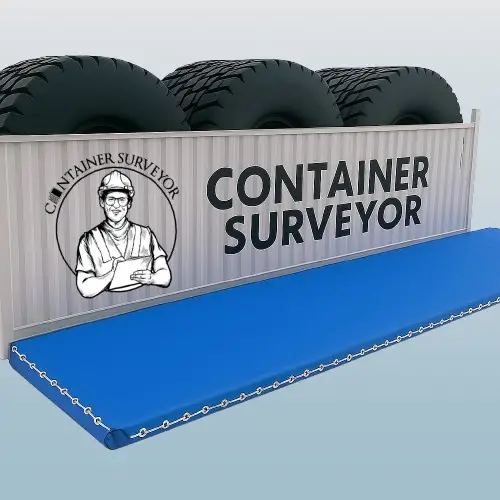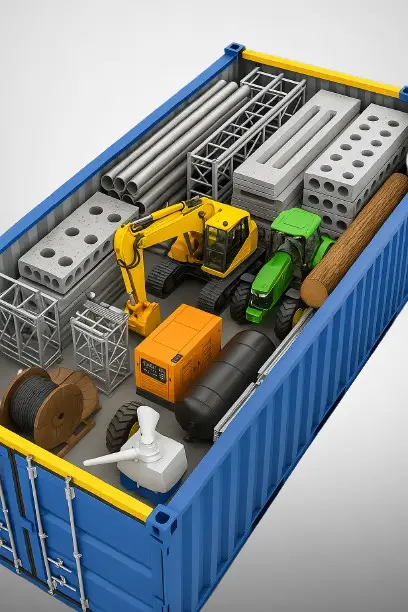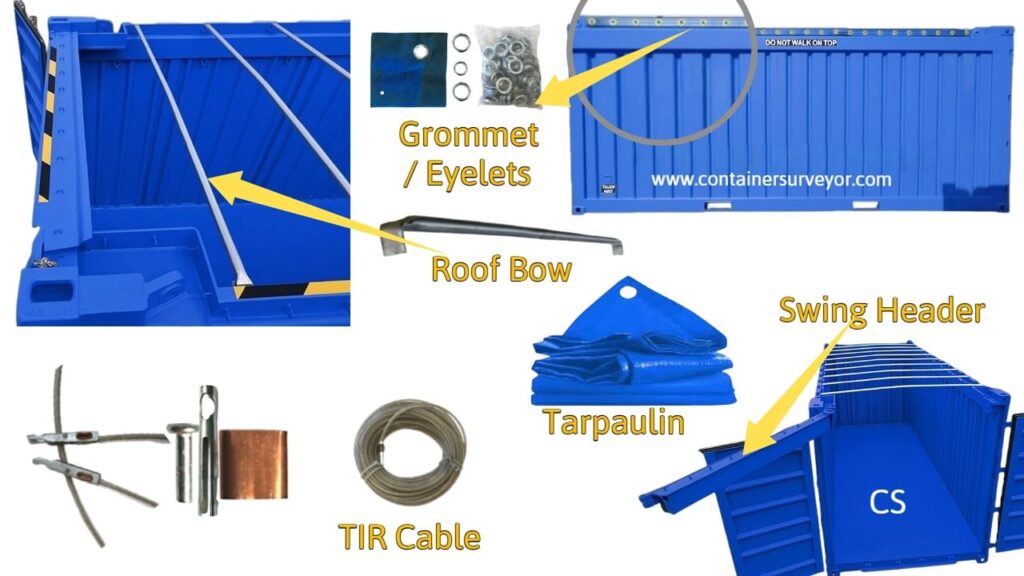Table of Contents
01. What is an Open Top Container & Why They Are Important ?

Open top containers can be identified as shipping containers without a fixed roof panel (roof or ceiling). This type of container is specifically designed to handle specialized cargo that falls under major categories such as construction, agricultural, and industrial equipment. In fact, open top containers are primarily used for oversized or irregularly shaped cargo that cannot be loaded through the standard container doors.
The absence of a roof panel allows these containers to be loaded and unloaded from the top, typically using cranes or other lifting equipment. Often, the cargo transported in open top containers exceeds the height of the container frame, which is why such shipments are commonly referred to as out of gauge (OOG) cargo.
Although open top containers do not have a fixed roof panel, they are equipped with a removable PVC tarpaulin cover and roof bows. The roof bows provide structural support to prevent the tarpaulin from sagging inward. When protection from weather, dust, or other external factors is required, the tarpaulin cover can be securely fastened over the cargo.
Additionally, some open top container models feature a swing header, which allows for easier and smoother loading and unloading operations. This feature enhances handling efficiency, especially when dealing with heavy machinery or tall equipment that needs vertical access.
1.1 Overview of Common Cargo Types Carried
Shippers usually avoid using dry containers when the goods do not fit properly inside regular containers. For example, machinery and industrial equipment are often too large and require additional space from the top. Some types of equipment also cannot be loaded through the usual container doors, but they can be easily loaded from the top using a crane.
This is the main reason why open top containers are widely used for oversized cargo, bulky cargo, or out-of-gauge (OOG) shipments. The open roof design allows convenient loading and unloading from above, making it suitable for transporting heavy and irregularly shaped goods that exceed standard container dimensions.
Some common examples of specific goods transported using open top containers include,

- Steel pipes and beams
- Concrete slabs and prefabricated panels
- Scaffolding and bridge components
- Excavators, bulldozers, and other heavy machinery
- Large generators, compressors, and transformers
- Machine parts and engines
- Timber logs and sawn wood
- Tractors, harvesters, and agricultural machinery
- Wind turbine parts and solar panel frames
- Oil and gas drilling equipment
- Boats, small yachts, and storage tanks
- Cable drums, industrial coils, and reels
- Vehicles with extended height
02. What are the sizes, types, and ISO codes of open top containers?
In general, we can find several standard sizes of open top containers commonly used in international shipping. The most frequently seen types are;
| Container Type | Common Name / Short Form | ISO Type Code |
|---|---|---|
| 20 foot standard open top container | 20′OT Container / 20′SOT Container | 22U1 Container |
| 20-foot high cube open top container | 20′HC OT Container | 25U1 Container |
| 40-foot standard open top container | 40′OT Container | 42U1 Container |
| 40-foot high cube open top container | 40′HC OT Container | 45U1 Container |
These are recognized worldwide as universal standard sizes for open top equipment. Apart from these common models, there are also other variations available depending on the cargo requirement and region. These include the 10-foot open top container, 45-foot open top container, 48-foot open top container, and half-height open top container.
03. Dimensions of an Open Top Container
| Feature | Measurement | OPEN TOP – 20′ DRY | OPEN TOP – 20′ HIGH CUBE | OPEN TOP – 40′ DRY | OPEN TOP – 40′ HIGH CUBE |
|---|---|---|---|---|---|
| Inside Measurement | Length Width Height | 5,898mm 2,350mm 2,348mm | 5,898mm 2,350mm 2,690mm | 12,022mm 2,350mm 2,348mm | 12,032mm 2,352mm 2,653mm |
| Door Opening | Width Height | 2,340mm 2,280mm | 2,340mm 2,565mm | 2,340mm 2,280mm | 2,340mm 2,585mm |
| Roof Opening | Length Width | 5,680mm 2,252mm | 5,680mm 2,252mm | 11,798mm 2,230mm | 11,806mm 2,192mm |
| Swing header opening | Width | 1,940mm | 1,940mm | 1,940mm | 1,940mm |
| Load Capacity | 32.5(m³) | 37.3(m³) | 66.3(m³) | 75.1(m³) | |
| Tare weight | 2240kg | 2,350kg | 3,880kg | 3890kg | |
| Pay Load | 28,240kg | 27,990kg | 26,600kg | 28,610kg |
04. What Makes an Open Top Container Different from a Dry Container?

| Component | Description | Open Top Container | Dry Container |
|---|---|---|---|
| Tarpaulin | Tarpaulin is a strong, waterproof cover used to protect the cargo inside an open top container. Since these containers do not have a solid roof, | The tarpaulin acts as a flexible cover that keeps the cargo safe from rain, sunlight, and dust during transport. | Has fixed roof panel |
| Roof Bows / Roof Bars | Roof bow is a removable metal beam that runs across the width of an open top container to support the tarpaulin cover and maintain the container’s structural strength and to hold up the tarpaulin. | Hold up the tarpaulin | Not Available |
| Swing Header | An open top container swing header is a removable or hinged crossbar located above the container’s door opening. | Allow full access to the container from the top when open | Fixed header |
| TIR Cord / TIR Cable | An open top container TIR cord is a steel wire or cable used to secure and seal the tarpaulin cover of an open top container. It runs through eyelets on the edges of the tarpaulin and the container’s locking points to ensure the cover cannot be opened without breaking the seal. | To seal the tarpaulin after loading and covering the cargo | Not Available |
| Grommet / Eyelets | Reinforced metal or rubber ring fitted into the edge of the tarpaulin cover used on open top containers. | These grommets create strong, tear-resistant holes through which ropes, cords, or TIR wires | Not Available |
05. Pros and Cons of Open Top Containers
| Pros | Cons |
|---|---|
| Easy Loading for Oversized Cargo: Ideal for goods too tall or irregularly shaped to fit through standard doors. | Limited Weather Resistance: Tarpaulin cover offers less protection than solid steel roofs. |
| Top Loading Access: Allows loading and unloading from the top using cranes or lifting equipment. | Higher Handling Costs: Loading with cranes or special equipment can increase expenses. |
| Versatile Cargo Handling: Suitable for machinery, timber, scrap metal, or project cargo. | Extra Charges Possible: Shipping lines may charge for tarpaulin or roof bow damages. |
| Removable Roof Structure: Roof bows and tarpaulin can be removed for flexible operations | Security Risks: Easier to tamper with compared to fully enclosed containers. |
| Durable and Weather-Protected: Tarpaulin cover provides good protection from rain and dust | Limited Availability: Fewer in circulation than standard dry containers, harder to book. |
06. Tips for Shippers and Consignees on Handling Open Top Containers
In this section, we are not going to discuss the loading or unloading process. Instead, let’s focus on some of the common issues that consignees face when returning empty open top containers at the destination yard.
Quite often, consignees experience trouble because the original tarpaulin is missing, or a duplicate tarpaulin has been used instead. In other cases, roof bows are missing, partially missing, or TIR cables are either lost, cut, or damaged. These issues usually lead to unnecessary disputes and additional charges during container return.
Let’s look at some key points both shippers and consignees should follow to avoid such problems.
From the Shipper’s Side
1. Confirm the tarpaulin status before shipment
Before you dispatch the cargo, check whether the container is shipped with or without the tarpaulin.
- If the tarpaulin is removed during loading, make sure to store it safely along with the TIR cable.
- It’s highly recommended to take clear photos of the tarpaulin and TIR cable in good condition before loading.
- After stuffing, capture a few images showing the container properly sealed with the tarpaulin and TIR cable attached. These will serve as solid proof in case of any future disputes.
2. Verify the roof bows at the loading port
Instruct your transporter or surveyor to check that all roof bows are in place and properly secured.
- If any roof bow is missing, request a container replacement or inform the carrier immediately.
- When removing roof bows due to cargo height, keep them safely aside and again, take photos for record.
3. Share all images and details with the consignee
Once the shipment is completed, send the photo set and notes to your consignee. This helps them identify what accessories were originally provided and their condition at the time of shipment.

From the Consignee’s Side

- Check the shipper’s instructions and photos upon cargo arrival
When you receive the container, review all images and notes sent by your shipper. This helps you confirm whether all accessories tarpaulin, TIR cable, and roof bows are still intact. - Avoid cutting the TIR cable unnecessarily
When removing the tarpaulin, cut the TIR cable only where required. Cutting it at the wrong place can make it unusable, and the container yard may charge for a replacement. - Avoid cutting the TIR cable unnecessarily
When removing the tarpaulin, cut the TIR cable only where required. Cutting it at the wrong place can make it unusable, and the container yard may charge for a replacement.
By following these simple but effective steps, both shippers and consignees can avoid unnecessary charges and disputes related to open top containers.
Please note that this section does not cover specific container damage cases, as the focus here is on preventive handling practices. However, if you’re interested in learning more about common types of container damages and how they occur, check out my article “5 Key Facts About Shipping Container Damages”, which explains in detail where and how damages can happen to containers.
In the above video titled “How to Put Its Tarpaulin,” you can clearly see what the roof bows, tarpaulin, and related components look like. It’s a good visual reference to understand how these parts are properly fitted and secured on an open top container. Make sure to get an idea from that video as well before handling or returning an open top container.
TIP: If you are capable of refitting the open top tarpaulin by yourself, there’s a good chance you won’t be charged tarpaulin fixing fees though this may vary depending on the shipping line or container operator.

